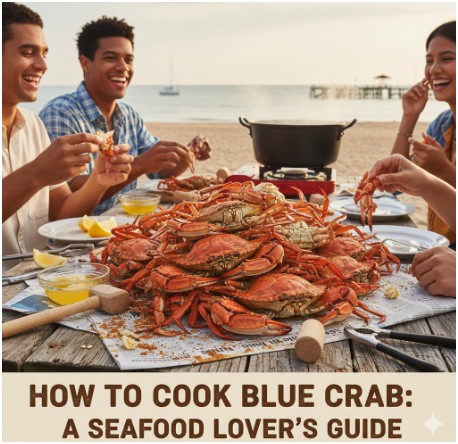My first taste of blue crab was on a windy Maryland wharf, and I can still remember it. While the villagers chuckled and gave me more melted butter, I was awkwardly cracking my claws on hot, Old Bay-coated shells.
One of my fondest culinary recollections is of that sloppy, mouthwatering feast. Since then, I’ve traveled to several nations and coasts to get the best seafood flavors, but few foods make me happier than mastering the art of properly cooking blue crab.
You’re in for a treat if you’re prepared to transform a mound of live crabs into a summertime supper by the beach. Although cooking blue crab isn’t difficult, it does require the proper technique, some flare, and fresh ingredients.
Why Is Steaming the Classic Way to Cook Blue Crab?
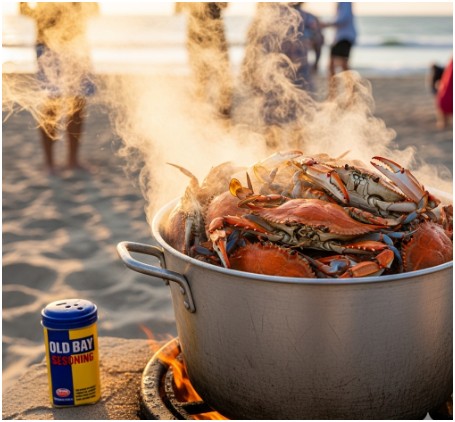
Steaming blue crab allows the meat to take center stage. In a manner that boiling occasionally cannot, steaming maintains its inherent sweetness and delicate texture.
This is the style that many in Maryland swear by: a hefty hand of Old Bay, a dash of vinegar, and a splash of beer.
End product is soft meat that retains its ocean-kissed flavor while incorporating just the right amount of seasoning.
I’ve cooked crabs in outdoor parties, on beaches, and even in tiny kitchens with barely enough room for a stockpot.
The whole room is filled with expectancy when those shells turn bright orange, no matter where you are. Steaming is magical because it combines tenderness, flavor, and tradition in a single pot.
Can You Boil Blue Crab Instead?
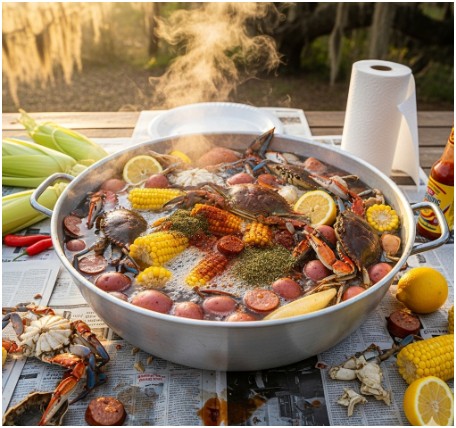
Of course! It takes less time to boil, particularly when feeding a large group of people. I discovered that a large pot of seasoned water is as much about community as it is about cuisine while I was in Louisiana.
In only a few minutes, you’ll have a feast fit for a table covered with newspapers as the crabs mix with lemons, bay leaves, and spices.
Boiling allows you to be flexible. Corn, potatoes, or sausage can all be added to the saucepan and allowed to absorb the same flavorful liquid.
those who enjoy a little spice in every bite, the crabs come out robust and peppery. Boiling shouts taste, whilst steaming murmurs it. Depending on your guests and your mood, both can be charming.
What Should You Know Before Cooking Blue Crab?
Blue crab begins to cook even before the stove is turned on. Always purchase live crabs. You don’t want to eat a crab that isn’t moving since it quickly loses its quality.
Until you’re ready, keep them moist and cold in a vented cooler with ice and newspaper.
Don’t worry if you get anxious around live crabs.
They become calmer, easier to handle, and their claws don’t pop off in the pot after a brief ice bath. If you’re trying to avoid juggling irate crabs, it’s a tiny step that makes a tremendous impact.
Before cooking, give the crabs a quick washing in cool water. Your finished dish will be cleaner and tastier after a brief wash to get rid of grit.
How to Make the Most of How to Cook Blue Crab
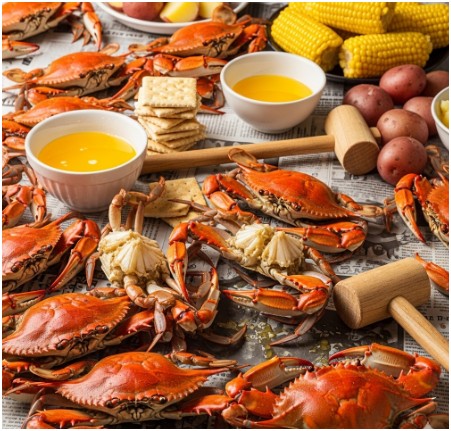
This is where things get useful. I’ll go over both steaming and boiling because they both have a place in your seafood playbook.
Use a large stockpot with a steamer rack to begin steaming. Just enough vinegar and light beer should be added to form a shallow layer beneath the rack.
Heat until it reaches a rolling boil. Rinse your crabs and arrange them in layers using tongs, liberally coating each with Old Bay or your preferred crab flavor.
Tightly cover and allow them to steam. It takes roughly ten minutes for small crabs and nearly twenty minutes for huge ones. They are prepared to burst when they emit a strong orange glow and a small amount of yellow “mustard.”
To boil, add salt, lemon, bay leaves, and crab boil mix to a large saucepan that is two-thirds full of water. Add the cooled crabs and bring to a boil. Depending on its size, cook it for 5 to 15 minutes with a lid on.
When their shells become reddish-orange, you’ll know they’re finished. Turn off the heat and let them soak in the seasoned broth for another 10 minutes if you want more flavor.
In both cases, the crabs are best enjoyed immediately. Place a piece of paper on the table, distribute crackers and mallets, and dig in while keeping melted butter close at hand. Even if cleaning up is dirty, it’s part of the enjoyment.
What Tools Do You Need to Eat Blue Crab?
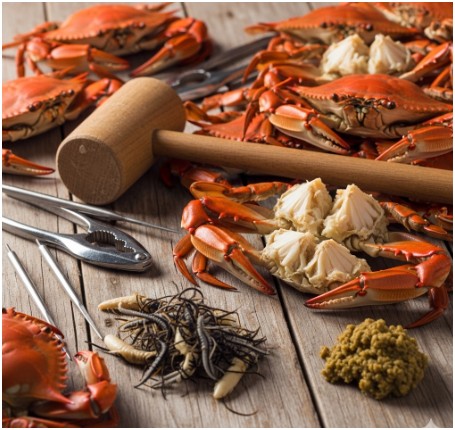
You don’t need a complex setup, but a few simple tools make the dinner more enjoyable. Claws can be cracked with wooden mallets without breaking the flesh inside.
Picks and crab crackers make it easier to get to those delicious morsels that are tucked away in awkward places.
Remember to bring plenty of napkins. Consuming blue crab requires active participation. Savoring each juicy bite with loved ones is more important than table etiquette.
Finally, when washing your crabs, throw away the gills, which are sometimes referred to as “dead man’s fingers.”
They cannot be eaten. In contrast, the yellow tomalley divides people. While some people put it aside, others adore its deep flavor. I advise you to try it once and make your own judgment.
Crack, Feast, Repeat: My Final Word on Blue Crab
The truth is that blue crab cooking is an experience rather than just a recipe once you master it. Food unites people in the messiest, happiest way possible—the steam, the spice, the crackling of shells around the table.
You will taste the sea itself if you are hot. You will taste a party in a pot if you are boiling. In any case, try not to overthink it. Seize your crabs, season them with love, and consume them right away. The true key to making blue crab unforgettable is that.
FAQs About How to Cook Blue Crab
Do I have to cook crabs while they’re alive?
Yes, always. Bacteria rapidly contaminate the meat of dead crabs, turning them mushy and dangerous. Live cooking guarantees safety, flavor, and freshness.
Is steaming really better than boiling?
What you desire will determine this. The crab meat remains soft and delicious when it is steamed. Boiling produces strong tastes and is a good way to add extras like corn and potatoes, or to make huge batches.
What seasoning works best?
The classic is Old Bay, particularly in Maryland. However, don’t be scared to try new things. I’ve had crabs flavored with lemon and pepper down south, but on the East Coast, combinations based on vinegar and mustard are typical.
Can I reheat cooked blue crabs?
They’re always best fresh, but you can. To reheat them without drying out the meat, you can steam them gently for a few minutes if you have to. Steer clear of the microwave; it will make the meat rubbery.

